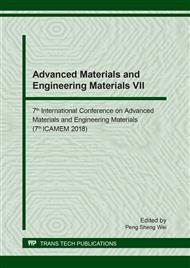[1]
Jeanson A C, Avrillaud G, Mazars G, et al. Determination of High Strain-Rate Behavior of Metals: Applications to Magnetic Pulse Forming and Electrohydraulic Forming[J]. Key Engineering Materials, 2014, 611-612:643-649.
DOI: 10.4028/www.scientific.net/kem.611-612.643
Google Scholar
[2]
Yan S, Wu H, Qi B. Experimental Validation and Constitutive Relationship of Steel Material under Elevated Temperature and High Strain Rate[C]. International Forum on Energy, Environment and Sustainable Development. (2016).
DOI: 10.2991/ifeesd-16.2016.47
Google Scholar
[3]
Tazuddin, Biswas K, Gurao N P. Deciphering micro-mechanisms of plastic deformation in a novel single phase fcc-based MnFeCoNiCu high entropy alloy using crystallographic texture[J]. Materials Science & Engineering A, 2016, 657:224-233.
DOI: 10.1016/j.msea.2016.01.065
Google Scholar
[4]
Armstrong R W, Walley S M. High strain rate properties of metals and alloys[J]. Metallurgical Reviews, 2008, 53(3):105-128.
DOI: 10.1179/174328008x277795
Google Scholar
[5]
Knezevic M, Beyerlein I J, Lovato M L, et al. A strain-rate and temperature dependent constitutive model for BCC metals incorporating non-Schmid effects: Application to tantalum–tungsten alloys[J]. International Journal of Plasticity, 2014, 62(12):93-104.
DOI: 10.1016/j.ijplas.2014.07.007
Google Scholar
[6]
Shi Jing,Zhang Weiqiang, Guo Jin. Constitutive Model of Plastic Deformation for Metal[J]. Material review, 2010, 24(04): 82-85.
Google Scholar
[7]
Gao N, Zhu Z W. Experimental Study of Wide Strain Rates and Constitutive Model Based on Damage of 5083 Aluminum Alloy[J]. Chinese Journal of High Pressure Physics, (2017).
Google Scholar
[8]
Chang Xuqing,Ma Tiehua,Yang Yongbiao. Dynamic mechanical behaviour of AZ31 magnesium alloy[J]. Journal of Measurement Science & Instrumentation, 2013,4(2):194-198.
Google Scholar
[9]
Cai J. A Comparative Study on Johnson Cook, Modified Zerilli–Armstrong and Arrhenius-Type Constitutive Models to Predict High-Temperature Flow Behavior of Ti–6Al–4V Alloy in α + β Phase[J]. High Temperature Materials & Processes, 2016, 35(3):297-307.
DOI: 10.1515/htmp-2014-0157
Google Scholar
[10]
D. Y. Sun, J. Li, F.C. Zhang, F.C. Liu, M. Zhang. Research on numerical algorithm of constitutive equation under high speed deformation in Hadfield steel. 2012 International Conference on Materials Engineering and Automatic Control , Apr.27-29, (2012).
DOI: 10.4028/www.scientific.net/amr.562-564.688
Google Scholar
[11]
Zhao X J, Fang Yun L U, Lin Y L. Research on Dynamic Compressive Testing and Mechanical Properties of Silicon Rubber[J]. Chinese Journal of High Pressure Physics, 2004, 18(4):328-332.
Google Scholar
[12]
Samantaray D, Mandal S, Bhaduri A K. A comparative study on Johnson Cook, modified Zerilli–Armstrong and Arrhenius-type constitutive models to predict elevated temperature flow behaviour in modified 9Cr–1Mo steel[J]. Computational Materials Science, 2009, 47(2):568-576.
DOI: 10.1016/j.commatsci.2009.09.025
Google Scholar
[13]
Orlikowski D, Correa A, Schwegler E, et al. A Steinberg-Guinan model for High-Pressure Carbon, Diamond Phase[C]. American Institute of Physics, 2007:247-250.
Google Scholar
[14]
Wang X, Hu J, Dai C, et al. Techniques for measuring ultrahigh-pressure Hugoniot equation of state on a three-stage gas gun[C]// APS Shock Compression of Condensed Matter Meeting. APS Shock Compression of Condensed Matter Meeting Abstracts, (2011).
DOI: 10.1063/12.0001235
Google Scholar
[15]
P. Mouro, G. Gary, H. Zhao. Dynamic tensile testing of sheet metal[J]. Journal De Physique Iv, 2000, 10:Pr9-149-Pr9-154.
DOI: 10.1051/jp4:2000925
Google Scholar
[16]
Chen W W, Song B. Split Hopkinson (Kolsky) Bar, Design Testing and Applications[J]. (2015).
Google Scholar
[17]
Gao N, Zhu Z W. Study on the Strain Rate Effects and Mechanisms for Aluminum Alloys[J]. Applied Mathematics & Mechanics, (2014).
Google Scholar
[18]
Zhang C Q, Xie L S, Chen M H, et al. Dynamic mechanical property and plastic constitutive relation of TC4-DT Ti alloy under high strain rate[J]. Chinese Journal of Nonferrous Metals, 2015, 25(2):323-329.
Google Scholar
[19]
Zan X, Chen X H, Huang W, et al. Rapid-contact Heating Technique in Tensile Impacts at Elevated Temperatures[J]. Journal of Experimental Mechanics, (2005).
Google Scholar
[20]
Xin L U, Jin H. The test of the elastic-plastic constitutive relation of aluminum alloy and copper alloy under high strain rate [J]. Journal of Plasticity Engineering, (2001).
Google Scholar
[21]
Tang T G, Li Q Z, Chen Y T, et al. An improved technique for dynamic tension of metal ring by explosive loading[J]. Explosion & Shock Waves, (2009).
Google Scholar
[22]
Oliveira D A, Worswick M. Electromagnetic forming of aluminium alloy sheet[J]. Journal De Physique IV, 2003, 110(1):293-298.
DOI: 10.1051/jp4:20020709
Google Scholar
[23]
Zheng LI, Jian-Hua H U, Meng Z H, et al. Study of high velocity constitutive equation of copper based on lectronmagnetic ring expansion[J]. Forging & Stamping Technology, 2009, 34(4):156-159.
Google Scholar
[24]
Sembian S, Liverts M, Tillmark N, et al. Plane shock wave interaction with a cylindrical water column[J]. Physics of Fluids, 2016, 28(5):741-757.
DOI: 10.1063/1.4948274
Google Scholar
[25]
Chen D N, Fan C L, Hu J W, et al. On constitutive models of oxygen-free high-conductivity copper at high pressure and high strain rates[J]. Acta Physica Sinica, 2009, 58(4):2612-2618.
Google Scholar


